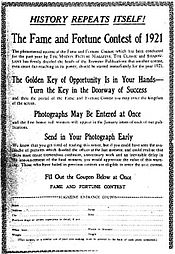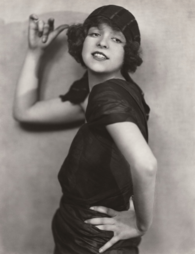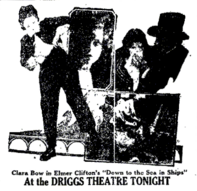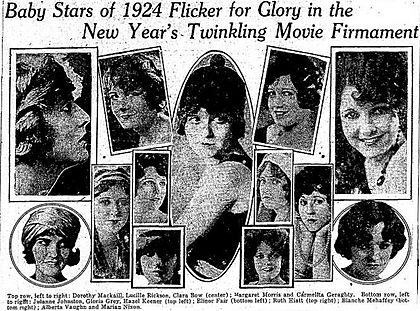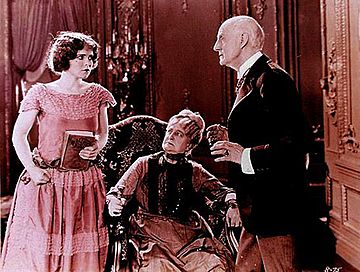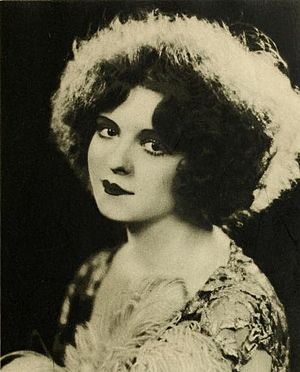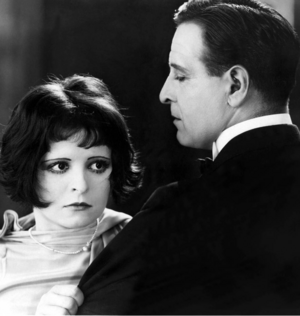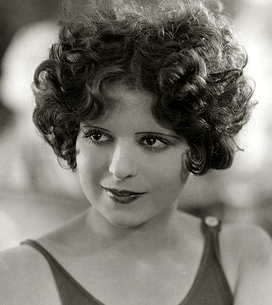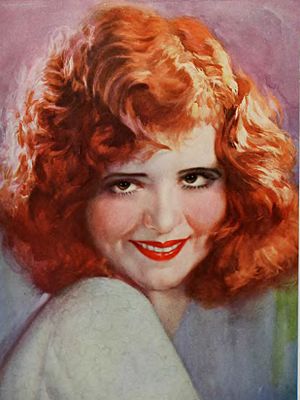Clara Bow facts for kids
Quick facts for kids
Clara Bow
|
|
|---|---|

in Rough House Rosie (1927)
|
|
| Born |
Clara Gordon Bow
July 29, 1905 |
| Died | September 27, 1965 (aged 60) Culver City, California, U.S.
|
| Resting place | Forest Lawn Memorial Park, Glendale |
| Nationality | American |
| Occupation | Actress |
| Years active | 1921–1933 |
| Known for | The original "It" Girl |
| Spouse(s) |
Rex Bell
(m. 1931; died 1962) |
| Children | 2 |
Clara Gordon Bow ( July 29, 1905 – September 27, 1965) was an American actress who rose to stardom in silent film during the 1920s and successfully made the transition to "talkies" after 1927. Her appearance as a plucky shopgirl in the film It brought her global fame and the nickname "The It Girl". Bow came to personify the Roaring Twenties.
She appeared in 46 silent films and 11 talkies, including hits such as Mantrap (1926), It (1927), and Wings (1927). She was named first box-office draw in 1928 and 1929 and second box-office draw in 1927 and 1930. At the apex of her stardom, she received more than 45,000 fan letters in a single month (January 1929).
Max Fleischer's cartoon character Betty Boop was modeled after Bow and entertainer Helen Kane (the "boop-boop-a-doop-girl").
After marrying actor Rex Bell in 1931, Bow retired from acting and became a rancher in Nevada. Her final film, Hoop-La, was released in 1933. In September 1965, Bow died of a heart attack at the age of 60.
Contents
Early life
Bow was born in Prospect Heights, Brooklyn at 697 Bergen Street. Her birth year, according to the US Censuses of 1910 and 1920, was 1905.
Bow was her parents' third child, but her two older sisters, born in 1903 and 1904, had died in infancy. Her mother, Sarah Frances Bow (née Gordon, 1880–1923), was told by a doctor not to become pregnant again, for fear the next baby might die as well. Despite the warning, Sarah became pregnant with Clara in late 1904. In addition to the risky pregnancy, a heat wave besieged New York in July 1905, and temperatures peaked around 100 °F (38 °C). Years later, Clara wrote: "I don't suppose two people ever looked death in the face more clearly than my mother and I the morning I was born. We were both given up, but somehow we struggled back to life."
Bow's parents were descended from English and Scots-Irish immigrants who had come to America the generation before. Bow said that her father, Robert Walter Bow (1874–1959), "had a quick, keen mind ... all the natural qualifications to make something of himself, but didn't ... everything seemed to go wrong for him, poor darling". By the time Clara was four and a half, her father was out of work, and between 1905 and 1923, the family lived at 14 different addresses, but seldom outside Prospect Heights, with Clara's father often absent.
When Bow's mother was 16, she fell from a second-story window and suffered a severe head injury. She was later diagnosed with "psychosis due to epilepsy". From her earliest years, Bow had learned how to care for her mother during the seizures, as well as how to deal with her psychotic and hostile episodes.
At age sixteen her mother was institutionalized. On January 5, 1923, Sarah died at the age of 43 from her epilepsy.
Bow attended P.S. 111, P.S. 9, and P.S. 98. (P.S. is Public School in New York City) As she grew up, she felt shy among other girls, who teased her for her worn-out clothes and "carrot-top" hair. She said about her childhood, "I never had any clothes. ... And lots of time didn't have anything to eat. We just lived, that's about all. Girls shunned me because I was so poorly dressed."
From first grade, Bow preferred the company of boys. In 1919, Bow enrolled in Bay Ridge High School for Girls. Bow's interest in sports and her physical abilities led her to plan for a career as an athletics instructor. She won five medals at the "cinder tracks" and credited her cousin Homer Baker—the national half-mile (c. 800 m) champion (1913 and 1914) and 660-yard (c. 600 m) world-record holder—for being her trainer. The Bows and Bakers shared a house—still standing—at 33 Prospect Place in 1920.
Career
Early years
In the early 1920s roughly 50 million Americans—half the population at that time—attended the movies every week. As Bow grew into womanhood, her stature as a "boy" in her old gang became "impossible". She did not have any girlfriends, and school was a "heartache" and her home was "miserable". On the silver screen, however, she found consolation; "For the first time in my life I knew there was beauty in the world. For the first time I saw distant lands, serene, lovely homes, romance, nobility, glamor". And further; "I always had a queer feeling about actors and actresses on the screen ... I knew I would have done it differently. I couldn't analyze it, but I could always feel it". "I'd go home and be a one girl circus, taking the parts of everyone I'd seen, living them before the glass." At 16, Bow says she "knew" she wanted to be a motion pictures actress, even if she was a "square, awkward, funny-faced kid."
Against her mother's wishes but with her father's support, Bow competed in Brewster publications' magazine's annual nationwide acting contest, "Fame and Fortune", in fall 1921. In previous years, other contest winners had found work in the movies. In the contest's final screen test, Bow was up against an already scene-experienced woman who did "a beautiful piece of acting". A set member later stated that when Bow did the scene, she actually became her character and "lived it". In the January issues 1922 of Motion Picture Classics, the contest jury, Howard Chandler Christy, Neysa McMein, and Harrison Fisher, concluded:
She is very young, only 16. But she is full of confidence, determination and ambition. She is endowed with a mentality far beyond her years. She has a genuine spark of divine fire. The five different screen tests she had, showed this very plainly, her emotional range of expression provoking a fine enthusiasm from every contest judge who saw the tests. She screens perfectly. Her personal appearance is almost enough to carry her to success without the aid of the brains she indubitably possesses.
Bow won an evening gown and a silver trophy, and the publisher committed to help her "gain a role in films", but nothing happened. Bow's father told her to "haunt" Brewster's office (located in Brooklyn) until they came up with something. "To get rid of me, or maybe they really meant to (give me) all the time and were just busy", Bow was introduced to director Christy Cabanne, who cast her in Beyond the Rainbow, produced late 1921 in New York City and released February 19, 1922. Bow did five scenes and impressed Cabanne with her ability to produce tears on call, but was cut from the final print. "I was sick to my stomach", she recalled and thought her mother was right about the movie business.
Early silent films
Encouraged by her father, Bow continued to visit studio agencies asking for parts. "But there was always something. I was too young, or too little, or too fat. Usually I was too fat." Eventually, director Elmer Clifton needed a tomboy for his movie Down to the Sea in Ships, saw Bow in Motion Picture Classic magazine, and sent for her. In an attempt to overcome her youthful looks, Bow put her hair up and arrived in a dress she "sneaked" from her mother. Clifton said she was too old, but broke into laughter as the stammering Bow made him believe she was the girl in the magazine. Clifton decided to take Bow with him and offered her $35 a week. Bow held out for $50 and Clifton agreed, but he could not say whether she would "fit the part". Bow later learned that one of Brewsters' subeditors had urged Clifton to give her a chance.
Down to the Sea in Ships, shot on location in New Bedford, Massachusetts, and produced by independent "The Whaling Film Corporation", documented life, love, and work in the whale-hunter community. The production relied on a few less-known actors and local talents. It premiered at the Olympia Theater in New Bedford, on September 25, 1922, and went on general distribution on March 4, 1923. Bow was billed 10th in the film, but shone through:
- "Miss Bow will undoubtedly gain fame as a screen comedienne".
- "Clara Bow who has reached the front rank of motion picture principal player ... [has] scored a tremendous hit in Down To The Sea In Ships."
- "With her beauty, her brains, her personality and her genuine acting ability it should not be many moons before she enjoys stardom in the fullest sense of the word. You must see 'Down to the Sea in Ships'".
- "In movie parlance, she 'stole' the picture ..."
By mid-December 1923, primarily due to her merits in Down to the Sea in Ships, Bow was chosen the most successful of the 1924 WAMPAS Baby Stars. In spring she got a part in The Daring Years (1923), where she befriended actress Mary Carr, who taught her how to use make-up. In the summer, she got a "tomboy" part in Grit, a story that dealt with juvenile crime and was written by F. Scott Fitzgerald. Bow met her first boyfriend, cameraman Arthur Jacobson, and she got to know director Frank Tuttle, with whom she worked in five later productions. Tuttle remembered:
Her emotions were close to the surface. She could cry on demand, opening the floodgate of tears almost as soon as I asked her to weep. She was dynamite, full of nervous energy and vitality and pitifully eager to please everyone.
Grit was released on January 7, 1924. The Variety review said, "Clara Bow lingers in the eye, long after the picture has gone." While shooting Grit at Pyramid Studios, in Astoria, New York, Bow was approached by Jack Bachman of independent Hollywood studio Preferred Pictures. He wanted to contract her for a three-month trial, fare paid, and $50 a week. "It can't do any harm," he said. "Why can't I stay in New York and make movies?" Bow asked her father, but he told her not to worry.
Preferred Pictures
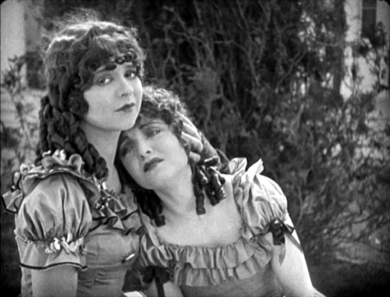
On July 22, 1923, Bow left New York, her father, and her boyfriend behind for Hollywood.
Maytime was Bow's first Hollywood picture, an adaptation of the popular operetta Maytime, in which she essayed "Alice Tremaine". Before the film was finished, Schulberg announced that Bow was given the lead in the studio's biggest film, Poisoned Paradise. But first she was lent to First National Pictures to co-star in the adaptation of Gertrude Atherton's 1923 best seller Black Oxen, shot in October, and to co-star with Colleen Moore in Painted People, shot in November. Director Frank Lloyd was casting for the part of high-society flapper Janet Oglethorpe, and more than 50 women auditioned, most with previous screen experience. Bow reminisced: "but he had not found exactly what he wanted and finally somebody suggested me to him ... When I came into his office a big smile came over his face and he looked just tickled to death." Lloyd told the press, "Bow is the personification of the ideal aristocratic flapper, mischievous, pretty, aggressive, quick-tempered and deeply sentimental." It was released on January 4, 1924.
Colleen Moore made her flapper debut in a successful adaptation of the daring novel Flaming Youth, released November 12, 1923, six weeks before Black Oxen. Both films were produced by First National Pictures, and while Black Oxen was still being edited and Flaming Youth not yet released, Bow was requested to co-star with Moore as her kid sister in Painted People (The Swamp Angel). Moore essayed the baseball-playing tomboy and Bow, according to Moore, said "I don't like my part, I wanna play yours." Moore, a well-established star earning $1200 a week—Bow got $200—took offense and blocked the director from shooting close-ups of Bow. Moore was married to the film's producer and Bow's protests were futile. Bow had sinus problems and decided to have them attended to that very evening. With Bow's face now in bandages, the studio had no choice but to recast her part.
In May, Moore renewed her efforts in The Perfect Flapper, produced by her husband; however, despite good reviews she suddenly withdrew.
Bow appeared in eight releases in 1924, two were released the same day.

In 1925, Bow appeared in 14 productions: six for her contract owner, Preferred Pictures, and eight as an "out-loan". Motion Picture Classic magazine wrote in June that "Clara Bow ... shows alarming symptoms of becoming the sensation of the year", and featured her on the cover.
I'm almost never satisfied with myself or my work or anything ... by the time I'm ready to be a great star I'll have been on the screen such a long time that everybody will be tired of seeing me ... (Tears filled her big round eyes and threatened to fall).
I worked in two and even three pictures at once. I played all sorts of parts in all sorts of pictures ... It was very hard at the time and I used to be worn out and cry myself to sleep from sheer fatigue after 18 hours a day on different sets, but now [Early 1928] I am glad of it.
Preferred Pictures loaned Bow to producers "for sums ranging from $1500 to $2000 a week" while paying Bow a salary of $200 to $750 a week. The studio, like any other independent studio or theater at that time, was under attack from "The Big Three", MPAA, which had formed a trust to block out Independents and enforce the monopolistic studio system. On October 21, 1925, Schulberg filed Preferred Pictures for bankruptcy, with debts at $820,774 and assets $1,420.
Three days later it was announced that Schulberg would join with Adolph Zukor to become associate producer of Paramount Pictures, "catapulted into this position because he had Clara Bow under personal contract".
Adolph Zukor, Paramount Picture CEO, wrote in his memoirs: "All the skill of directors and all the booming of press-agent drums will not make a star. Only the audiences can do it. We study audience reactions with great care." Adela Rogers St. Johns had a different take; in 1950, she wrote, "If ever a star was made by public demand, it was Clara Bow." And Louise Brooks (from 1980): "[Bow] became a star without nobody's help".
The Plastic Age was Bow's final effort for Preferred Pictures and her biggest hit up to that time. Bow starred as the good-bad college girl, Cynthia Day, against Donald Keith. It was shot on location at Pomona College in the summer of 1925, and released on December 15, but due to block booking, it was not shown in New York until July 21, 1926.
Bow began to date her co-star Gilbert Roland, who became her first fiancé.
Paramount Pictures
Bow was keen on poetry and music, but according to Rogers St. Johns, her attention span did not allow her to appreciate novels. Bow's focal point was the scene, and her creativity made directors call in extra cameras to cover her spontaneous actions, rather than holding her down.
Years after Bow left Hollywood, director Victor Fleming compared Bow to a Stradivarius violin: "Touch her, and she responded with genius." Director William Wellman was less poetic: "Movie stardom isn't acting ability—its personality and temperament ... I once directed Clara Bow (Wings). She was mad and crazy, but WHAT a personality!". And in 1981, Budd Schulberg described Bow as "an easy winner of the dumbbell award" who "couldn't act," and compared her to a puppy that his father B. P. Schulberg "trained to become Lassie."
Bow appeared in eight releases in 1926: five for Paramount, including the film version of the musical Kid Boots with Eddie Cantor, and three loan-outs that had been filmed in 1925. In late 1925, Bow returned to New York to co-star in the Ibsenesque drama Dancing Mothers, as the good/bad "flapperish" upper-class daughter Kittens. The picture was released on March 1, 1926. Local reviews were very positive.
On April 12, 1926, Bow signed her first contract with Paramount: "to retain your services as an actress for the period of six months from June 6, 1926 to December 6, 1926, at a salary of $750.00 per week".
On August 16, 1926, Bow's agreement with Paramount was renewed into a five-year deal: "Her salary will start at $1700 a week and advance yearly to $4000 a week for the last year." Bow added that she intended to leave the motion picture business at the expiration of the contract, i.e., in 1931. In 1927 Bow appeared in six Paramount releases: It, Children of Divorce, Rough House Rosie, Wings, Hula and Get Your Man. In the Cinderella based story It, the poor shop-girl Betty Lou Spence (Bow) conquers the heart of her employer Cyrus Waltham (Antonio Moreno). The personal quality—"It"— provides the magic to make it happen. The film gave Bow her nickname, "The 'It' Girl."
In 1927, Bow starred in Wings, a war picture rewritten to accommodate her, as she was Paramount's biggest star. The film went on to win the first Academy Award for Best Picture. In 1928, Bow appeared in four Paramount releases: Red Hair, Ladies of the Mob, The Fleet's In, and Three Week-Ends, all of which are lost. Adela Rogers St. Johns, a noted screenwriter who had done a number of pictures with Bow, wrote about her:
Sound films
With "talkies" The Wild Party, Dangerous Curves, and The Saturday Night Kid, all released in 1929, Bow kept her position as the top box-office draw and queen of Hollywood. Neither the quality of Bow's voice nor her Brooklyn accent was an issue to Bow, her fans, or Paramount.
With Paramount on Parade, True to the Navy, Love Among the Millionaires, and Her Wedding Night, Bow was second at the box-office only to Joan Crawford in 1930. With No Limit and Kick In, Bow held the position as fifth at box-office in 1931, but the pressures of fame, public scandals, and overwork, took their toll on Bow's fragile emotional health.
Bow left Hollywood for Rex Bell's ranch in Nevada, her "desert paradise", in June and married him in then small-town Las Vegas in December.
Death
Bow spent her last years in Culver City, Los Angeles, under the constant care of a nurse, living off an estate worth about $500,000 at the time of her death. She died of a heart attack on September 27, 1965, at the age of 60. An autopsy revealed that she suffered from atherosclerosis, a disease of the heart that can begin in early adolescence. Bow's heart showed scarring from an earlier undetected heart attack.
She was interred in the Freedom Mausoleum, Sanctuary of Heritage at Forest Lawn Memorial Park Cemetery in Glendale, California. Her pallbearers were Harry Richman, Richard Arlen, Jack Oakie, Maxie Rosenbloom, Jack Dempsey, and Buddy Rogers.
Legacy
In 1999, film historian Leonard Maltin said, "You think of Greta Garbo, Lillian Gish, all these great names, great actresses, Clara Bow was more popular in terms of box-office dollars, in terms of consistently bringing audiences into the theaters, she was right on top."
Awards and honors
- For her contributions to the motion picture industry, Bow was awarded a star on the Hollywood Walk of Fame in 1960.
- In 1994, she was honored with an image on a United States postage stamp designed by caricaturist Al Hirschfeld.
Filmography
Images for kids
-
Bow's crypt at Forest Lawn Memorial Park, Glendale. The marker erroneously cites Bow's birth year as 1907, although she was born in 1905.
See also
 In Spanish: Clara Bow para niños
In Spanish: Clara Bow para niños



